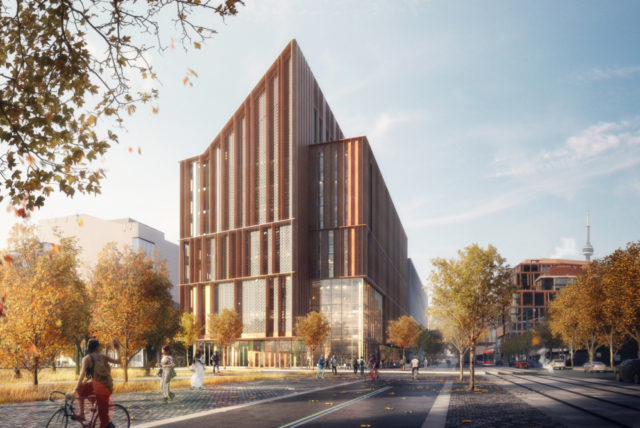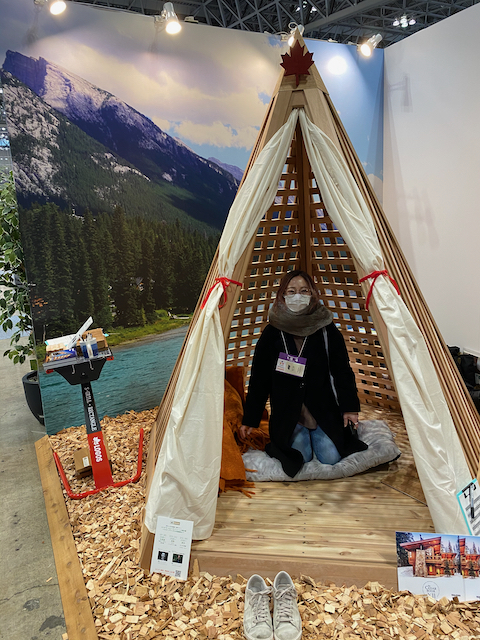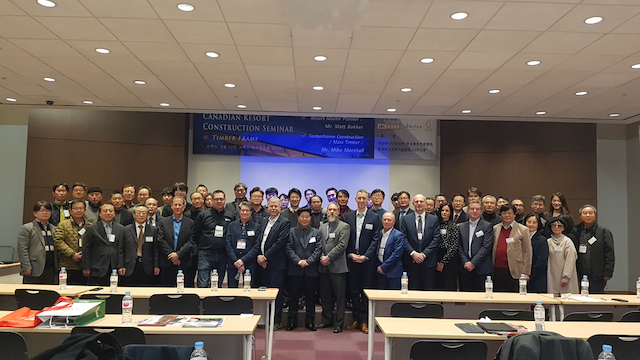SUBSCRIBE

Keep up-to-date
with BC Wood
  |
|
|
|
Due to the current COVID-19 situation, the BC Wood office will be operating with limited access and personnel. Please call or email ahead of time, if you wish to schedule an appointment to see one of our staff. Thank-you for your understanding and cooperation at this time.
|
| Announcement |
|
Changes to the Manufactured Forest Products Regulation
Ministry of Forests, Lands, Natural Resource Operations and Rural Development
One of Governments key objectives of the Coast Forest Sector Revitalization Initiative is to rebuild the solid wood and secondary industries to ensure more BC logs and fibre are processed in the province.
The Province made changes to the Manufactured Forest Products Regulation (MFPR) that will come into effect July 1, 2020 to ensure fibre is available to local manufacturers. The goal is to support local employment and encourage more value from our public resources.
Reduced fibre availability to local manufacturers was particularly concerning for Western Red Cedar and Cypress, where much of this high-value, minimally processed lumber was being shipped out of the province for further processing.
When timber is manufactured into a sawn-wood product, as defined in the MFPR, it may be exported without being advertised to the domestic market or paying a fee in lieu of manufacture. Under the amended regulation, effective July 1, 2020, the maximum dimension of lumber to be considered a sawn-wood product is now reduced to 0.1 m2 (~12"x12"), from the previous 0.2 m2 (~17"x17"). Timber larger than 0.1 m2 in cross section would require an exemption and payment of a fee in lieu of manufacture, before it could be exported.
The regulation amendments also require that lumber products made from Western Red Cedar or Cypress to be fully manufactured prior to export. Western Red Cedar or Cypress that is not fully manufactured will require an exemption in order to be eligible for export and a fee in lieu of manufacture applied. Western Red Cedar or Cypress lumber that is a final product (e.g. rough green timbers for landscaping) are considered fully manufactured and would be eligible for export without an exemption and without paying a feel in lieu of manufacture.
The Province wants to work collaboratively with industry stakeholders to develop the right exemptions to meet the objectives of the regulation. For example, custom cut Western Red Cedar or Cypress lumber that is shipped overseas to a customer who will specialty manufacture it into a finished product, is not intended to be captured by the regulation. The exemptions have not been developed yet and we want to hear from you.
Government has formed a working group with key industry representatives to help develop the exemption process. Associations represented on the working group include: BC Wood, COFI, ILMA, IWPA, WRCLA and a group of independent forest companies. Associations will disseminate information to their members and ensure information from their members is provided to Government through the working group.
Government has also hired Jim Cross to meet with industry representatives and businesses to support ministry staff to develop a broad understanding of how to meet the goals of the regulation, while ensuring that it make senses for your sector and operations. These meetings have started and will continue throughout the process.
To help keep you informed we will continue to update our website (MFPR) with further information, including frequently asked questions.
If you have questions, please send us an email at
[email protected]
|
| Industry News |
Building Community with B.C. wood
In small towns and remote communities throughout British Columbia, local residents are using sustainably harvested B.C. wood to build arts, cultural and community centres - places where people can play, gather and access services.
Many communities founded on forestry are returning to their roots by constructing landmark buildings and community amenities with local wood products and using local expertise, labour and manufacturers.
On the East Coast of central Vancouver Island, École au-cœur-de-l'île is a modern school by day and a hub for the local Francophone community at night. Sustainably harvested wood is used in McFarland Marceau Architects' plan throughout the building. Interior spaces use exposed glue-laminated timber (glulam) beams and mass timber panels to form unique reading alcoves and multi-purpose spaces. The nearly 3,000-square-metre roof is made of timber. Reclaimed Douglas-fir from the site's previous building was used to create a 7.5-metre glazing wall, with more salvage wood used as benches and display cabinets.
|
| Industry News |
|
San Group's Remanufacturing Plant Takes Shape in Port Alberni
Susie Quinn | Alberni Valley News
San Group's remanufacturing plant is taking shape at the corner of Stamp Avenue and Roger Street in Port Alberni.
The forestry company already has a sawmill in Port Alberni, and they have been preparing this particular site for a remanufacturing plant, several specialty kilns and value-added machinery.
The frame for the fabric building was most noticeable to the public as it was going up, but it is only one facet of the plan for that site, says Bob Bortolin, vice-president of business development for the Surrey-based company.
|
| Industry News |
|
Engineers Describe their Most Innovative Timber Projects
Matthew Marani | Architect's Newspaper

AN surveyed some of the leading practices in
timber
structure and facade engineering about the most innovative projects they worked on over the past year. Their responses highlight advanced applications of timber, ranging from a hybrid tower underway in Canada to greenhouse domes popping up in China.
Paul Fast
Founding Partner, Fast + Epp
Perhaps the most groundbreaking project we have been working on this year is Moriyama & Teshima Architects' The Arbour, a new ten-story building for George Brown College in Toronto. It features a novel structural system consisting of the slab-band arrangement commonly used in concrete construction but replaces most of the concrete with mass timber. Composite CLT-concrete slab bands with an overall thickness of 15.5 inches span 30 feet between large 1.4-foot- by-3.9-foot timber columns, and infill 6-inch- thick CLT panels clear span 15.5 feet between the slab bands. Central stair and elevator cores consisting of steel columns and diagonal bracing provide lateral resistance for the building. The end result is a primarily timber construction floor system that offers a thickness and flat soffit comparable to concrete construction but with a sharp reduction in both embodied carbon and construction time. The exposed timber flooded by ample daylight will also create a wonderful physical work environment for students and faculty.
|
| Industry News |
|
Timber Towers Grow to New Heights: 7 Projects to Watch
The Urban Developer

News that ASX-listed software giant Atlassian has plans to build a $1 billion timber tower as part of the Sydney central station
tech and innovation hub was revealed earlier this
month.
The hybrid cross-laminated timber
tower joins a growing number of major multi-storey timber projects
internationally.
The lightweight timber structures use a hybrid construction method to push height boundaries with a concrete core to stabilise them against the wind.
However, a recent set of plans shied away from this method-developed by Sidewalk Labs from Alphabet, the parent company of Google.
The plans reveal an entire "mass-timber" precinct including a 35-storey tower with a timber exoskeleton in Toronto, Canada.
|
| Industry News |
|
Selling Cedar in the Age of Climate Change
Simon Cameron | Building Products Digest

The push to more eco-friendly behavior is changing how we live. It's affecting our choices in small, incidental actions like using re-fillable coffee cups and recycling plastic bags, to larger life milestones such as the kind of cars we drive or the materials our homes are made of.
Consumers are now expecting businesses to do their part, as well. In a recent Nielsen study, 81% of respondents strongly agreed that companies should take responsibility for improving the environment. The world is demanding action on climate change, and that action is now being seen in what motivates consumers to choose one product over another.
In this respect, natural, climate-friendly and sustainable products like wood may soon have the upper hand over composite products at the retail level, particularly as awareness of climate change grows. For the past decade or so, composite materials have been a growing threat to wood decking and siding products, but little has been said about the environmental impact these products have.
|
| Industry News |
|
Export Ready: Understanding Global Money
Tuesday, March 24, 2020 | 9:30AM to 11:00AM
Tradeshows are crucial to expanding your sales outside B.C.'s borders. But the culture, etiquette and expectations of doing business in each country are different. So how do you prepare?
Join us for this free interactive seminar and learn the dos and don'ts of international business, how to get the most of out of your trip, and learn about the cultural elements that impact business decision-making.
Hear insights from Allison Boulton, Program Manager of Export Navigator, as well as a guest speaker from Export Development Canada.
Key takeaways:
- Learn how to prepare for a tradeshow and the funding programs to get you there
- Find out how to develop tradeshow leads and have more successful interactions
- Learn about upcoming B.C. and Canadian pavilions at trade shows around the world
- Discover key etiquette and culture tips for doing business cross-culturally
|
| Asian Market |
|
Asian Market Update Winter 2020
Jim Ivanoff | [email protected]
Korea
 Every year the January to March period is a busy time for BC Wood's Asian programs. Our first activity was the Housing Brand Fair in Seoul which took place from February 13th to 16th. With the corona virus outbreak in China on everyone's minds, the organizers took various screening and preventative measures to protect both the exhibitors and visitors. Unfortunately, attendance was still down, but despite this our members were able to meet key importers and buyers, creating new business opportunities. The BC Wood organized Canadian Pavilion was home to member companies covering packaged-homes, Western Red Cedar, remanufactured products, as well as furniture. Every year the January to March period is a busy time for BC Wood's Asian programs. Our first activity was the Housing Brand Fair in Seoul which took place from February 13th to 16th. With the corona virus outbreak in China on everyone's minds, the organizers took various screening and preventative measures to protect both the exhibitors and visitors. Unfortunately, attendance was still down, but despite this our members were able to meet key importers and buyers, creating new business opportunities. The BC Wood organized Canadian Pavilion was home to member companies covering packaged-homes, Western Red Cedar, remanufactured products, as well as furniture.
BC Wood also delivered technical seminars in Seoul and on Jeju island during the week of the Housing Brand Fair. The topic was Developing All-

Season Resorts using Successful Canadian Resorts as examples. We brought in a resort master planner to talk about how to properly plan and develop all-season resorts, as well as an experienced mass timber construction company who introduced in detail a variety of resort infrastructure built in BC utilizing wood. We had good attendance figures in both Jeju and Seoul, with many participants thanking us for offering such information that was very new and fresh for the Korean market.
Japan
Right after the Housing Brand Fair, BC Wood once again exhibited at the HoteRes Show in Tokyo on behalf of our industry. This show targets the Japanese hospitality industry and has been providing us with great new contacts at resort and hotel developments. HoteRes has given us a brand-new route to promote products from furniture, millwork, and WRC to engineered wood and log and timberframe packages.
 From March 9th to 11th we brought over the same instructors that had come to Korea to Japan and delivered the same talks in Sapporo, Nagano, and Tokyo. Over the past few years as we have targeted the Japanese resort sector, many Japanese developers and local governments have asked us for such information on BC resorts, leading to tremendous interest in these programs. Unfortunately, the corona virus situation in Japan has led many organizations to ban staff from taking part in external events, so many participants had to reluctantly cancel. Despite the lower attendance than we had anticipated, it was still worthwhile to deliver them, as many high value targets such as resort owners and developers still attended. From March 9th to 11th we brought over the same instructors that had come to Korea to Japan and delivered the same talks in Sapporo, Nagano, and Tokyo. Over the past few years as we have targeted the Japanese resort sector, many Japanese developers and local governments have asked us for such information on BC resorts, leading to tremendous interest in these programs. Unfortunately, the corona virus situation in Japan has led many organizations to ban staff from taking part in external events, so many participants had to reluctantly cancel. Despite the lower attendance than we had anticipated, it was still worthwhile to deliver them, as many high value targets such as resort owners and developers still attended.
|
|
| Upcoming Events |
|
Please stay tuned for our listings of the 2020/21 program events.
|
If you have any questions, comments, suggestions, or feedback, feel free to email me at
[email protected].
Sincerely,
Kit Crowe
BC Wood |
|
|